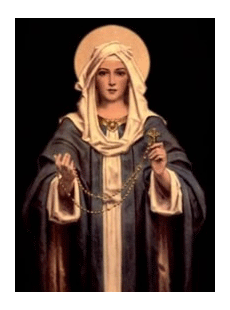HOLY ROSARY
October is the month of the Rosary, because of the anniversary of victory at the Battle at Lepanto and the feast of Our Lady of the Rosary occurring in October. The Battle of Lepanto and the institution of the feast day took place in the 17th century; in the late 1800s, Pope Leo XIII officially dedicated the entire month to devotion to the Holy Rosary.

History of the Rosary
The rosary was originally called the Psalter of the Blessed Virgin Mary because Our Lady is venerated by the angelic greeting (the Hail Mary) repeated one hundred fifty times, corresponding to the number of the Davidic Psalter, and by the Lord’s Prayer before each decade. Superimposed on these prayers are certain meditations showing forth the entire life of Our Lord Jesus Christ, thus completing the method of prayer devised by the Fathers of the Holy Roman Church. In this we see that the rosary actually has its origin partly in the Divine Office, the official prayer of the Church, in which all 150 Psalms are recited/chanted in the course of each week.
The 150 Davidic Psalms (the Psalter of David) have always been prayed by Old Testament Israel, by post-Temple Jews, and by Christians for personal prayer, communal prayer, lamentations, praise, thanksgiving, and, in the case of Christians, to demonstrate the fulfillment of prophecy. They came to form a large part of the Divine Office sung at the various canonical hours by religious. Lay people who did not have copies of Scripture or the Breviary and lay people and religious who were illiterate would substitute 150 Pater Noster’s (Our Father’s) or Ave’s (Hail Mary’s) for the 150 Psalms they could not read.
The prayers were originally counted by transferring pebbles from one bag to another, but soon enough Christians began to tie a rope with knots on which to count. This evolved further into using beads or pieces of wood in place of the knots, and this soon came to be called the “Psalter of the Laity”. Around the end of the first millennium, rosaries contained the present five decades (sets of ten beads), with the Ave beads shaped like white lilies for the purity of the Virgin and the Pater beads shaped like red roses for the wounds and Passion of Christ.
St. Dominic de Guzman popularized the Marian Psalter in the form we have it today (150 Aves with a Pater after each 10), the founder of the order of Friar Preachers, having recourse to the Blessed Virgin in order to stem the flood of the Albigensian heresy, which was spreading itself like a plague over many countries, but especially over France, instituted, by special revelation from her, in the year 1206, and afterwards very effectually promulgated, the devotion of the holy Rosary, which ever since has produced now for many ages the most marvellous results in the Christian world. So associated with the Rosary is St. Dominic that the Rosary is often called the “Dominican Rosary”.
The Rosary, thus, has always been a weapon against heresy and trouble. In fact, the October 7, 1571 victory of Christendom over Islamic warriors at the Battle of Lepanto – the first naval victory against the infidels – was attributed directly to the rosaries prayed by the faithful.

Spiritual Fruits
The rosary is presented both as a “school of faith” and a “school of charity.” Meditation on the mysteries of salvation is to lead to conversion of heart and change of conduct. Contemplation on the mysteries is essentially a loving act of gratitude through which the heart is “filled with love...hope enlarged, and the desire increased for those things which Christ has prepared for such as have united themselves to Him in imitation of His example and in participation in His sufferings.” Attentive consideration of the “precious memorials” of our Redeemer leads to “a heart on fire with gratitude to Him.”
The rosary, the popes teach, is also meant to influence society as a whole. Several papal encyclicals speak of the social consequences, or the effects on society, which meditation on the mysteries of the rosary could produce. The holy and powerful life of Jesus Christ is to be a real antidote and remedy for the errors afflicting society. Our Lord’s example and that of His Mother are brought before our mind’s eye to be our encouragement and the sure path through life’s joys and sorrows. We must recall the command of Our Lady at her apparitions, both at Lourdes and at Fatima, that we must pray the rosary for sinners.
All of the popes have earnestly desired that the Holy Rosary should be recited especially during the month of October with increased devotion and with the utmost possible zeal, both in the churches and in homes. They urge that the Christian people should be led by its recitation to understand the dignity, the power, and the excellence of the Holy Rosary.
You can do it, too! Sign up for free now at https://www.jimdo.com
